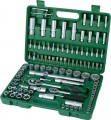Socket heads (E-profile)
The number
of E-profile sockets supplied with the tool kit.
All end heads are accessories for a collapsible tool; during operation, they are mounted on a ratchet, wrench or other similar device. The head itself has the appearance of a characteristic “cap”, which, during operation, is put on a bolt, nut, etc. This design, among other things, allows you to work with parts located in recesses and some other hard-to-reach places that cannot be reached with open-ended, captive or split keys. And compared to a set of classic socket wrenches, the holder plus socket set takes up much less space, providing almost the same functionality.
Specifically, this type of heads has a working part in the form of a six-pointed star, which is why such nozzles are also called “asterisks”, “Torx” or “internal Torx”. The latter option is used to avoid confusion with Torx keys (see above): the working part of such a key (“external Torx”) has the form of a star-shaped rod, while in the end head the working part has the form of a recess with similar outlines. As for the use of such heads, when used with “native” fasteners, the E-profile allows you to work at high forces without much risk of breaking the edges; and fasteners are used for such tools, in particular, in cars.
Socket heads sizes (E-profile)
Working size range of E-profile sockets (see above) supplied with the kit. This parameter allows you to evaluate how the heads fit the dimensions of the fasteners with which they are planned to be used.
Adapter
An adapter for docking seemingly incompatible elements from a set. For example, socket heads with an unsuitable landing square on a ratchet, screwdriver handle or in a drill driver.
The adapter provides full-fledged work with all the required list of tools from the set.
Hex wrenches
The number of
hex wrenches supplied in the kit. Note that some modern kits include
only hex wrenches, without any other fixtures or accessories. It is also worth emphasizing that in this case we are talking about the simplest hex wrenches. Imbus tools — similar in purpose, but different in design — are highlighted in our catalog in a separate category (see below),
Keys of this type usually have the form of L-shaped handles made of a hexagonal rod. Thus, the user can work with both the short and long side of the key; in the first case, the long part of the letter "G" works as a lever, providing a good effort, in the second — it plays the role of an extension. And such tools are used for bolts and other similar parts with a hexagonal cut in the cap. Such splines have a number of advantages over the classic straight and cross splines (in particular, better tolerating high torques), which makes them quite popular — in particular, in bicycles.
As for the quantity, it is worth considering here: sets with the same number of keys of the same type may differ in the specific sizes of these tools. Such nuances should be clarified before buying separately.
Hex wrenches size
Working size range of hex wrench sizes (see above) supplied with the kit. This parameter allows you to evaluate how the keys fit the dimensions of the fasteners with which they are planned to be used.
Weight
The total weight of the tool kit. Indicated with a case, stand or other storage/transportation device (see Tool Storage). First of all, you should pay attention to this parameter if you plan to often carry the kit over long distances — the lighter the weight, the easier it will be to do. At the same time, extensive sets inevitably turn out to be weighty.

